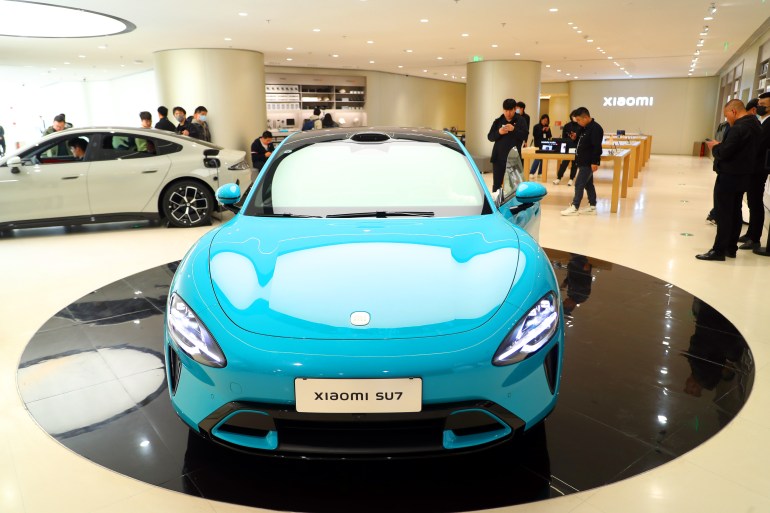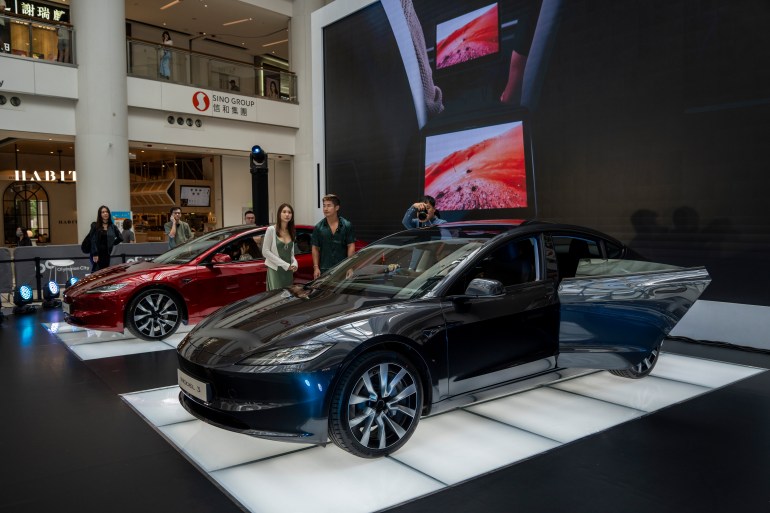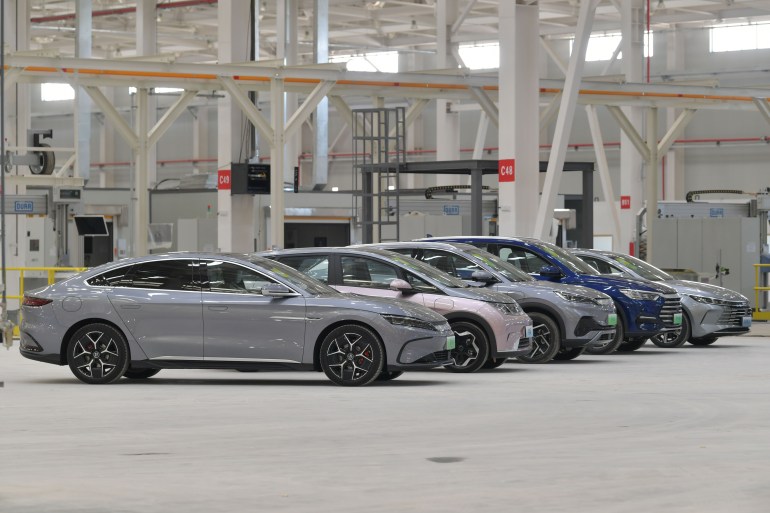Western car makers, already bruised by the scramble among themselves for a share of the electric vehicle (EV) market, are facing a much more fearsome foe – China and its aggressive investment into the sector.
Tesla, perhaps the best-known of the EV manufacturers in Western markets, saw first-quarter sales down by 20 percent this year, compared with the same period in 2023, and its share price has slumped by more than 25 percent since the beginning of this year.
According to experts, this is at least partially due to the emergence of a much more competitive landscape, with Xiaomi, originally a smartphone manufacturer which is has its headquarters in Beijing, launching its first EV – the SU7 – just a few weeks ago.
 Consumers view Xiaomi’s new SU7 at the Xiaomi Electric Vehicle Flagship Store on April 2, 2024, in Beijing, China [VCG/VCG via Getty Images]
Consumers view Xiaomi’s new SU7 at the Xiaomi Electric Vehicle Flagship Store on April 2, 2024, in Beijing, China [VCG/VCG via Getty Images]The competition from Chinese manufacturers has forced Western EV makers to sit up and take notice.
On a call with analysts in January this year, Tesla boss Elon Musk stated: “Our observation is, generally, that the Chinese car companies are the most competitive car companies in the world.”
“I think they will have significant success outside of China,” he added.
This was quite a change in tone from 2011 when he was asked about competition from BYD (Build Your Dream), China’s largest EV car manufacturer, on Bloomberg TV, and laughed in response. When asked by former Bloomberg anchor Betty Liu, “Why do you laugh?”, Musk mockingly replied: “Have you seen their cars? You don’t see them at all as a competitor. I don’t think they have a great product.”
How popular are Chinese EVs?
Chinese EVs already make up 60 percent of worldwide sales, according to International Energy Agency, a Paris-based energy consultant. Tesla and BYD have been battling it out for market share for the last couple of years.
According to market research firm TrendForce’s February 2024 report, Chinese manufacturers already hold three of the top five spots for global market share – with BYD at 17 percent, GAC Aion at 5.2 percent and SAIC-GM-Wuling at 4.9 percent. Tesla is clinging on to the top spot with a market share of 19.9 percent while German manufacturer Volkswagen is in the fifth spot with a market share of 4.6 percent. By comparison, Chinese manufacturers were responsible for just 0.1 percent of global EV sales in 2012 – just 12 years ago.
How do Chinese EVs compare in terms of safety?
According to 12365Auto, a Chinese website that monitors car quality using a system which counts the number of faults per 10,000 vehicles sold to quantify customer satisfaction, Tesla cars remain at the top and third spots (for different models of car) for the least amount of faults. However, the percentage difference in faults between Tesla and other Chinese EVs is marginal.
Are Chinese EVs much cheaper than Tesla et al?
Currently, some Chinese EV models are available to car consumers in Europe but not in the United States. The nearest country to the US where Chinese EVs are sold is Mexico – and they are somewhat cheaper.
The Dolphin Mini from Chinese manufacturer BYD costs $21,000 to buy in Mexico. The cheapest US equivalent, by comparison, would be the Nissan Leaf at $29,000 or the Chevrolet Bolt at about $27,000. In China, however, the Dolphin Mini costs just 69,800 yuan ($9,640) because of the competition from other Chinese manufacturers.
The price of a BYD Yuan Plus (sold as the Atto 3 outside of China), starts at 119,800 yuan ($16,550) both inside and outside China. While it can’t match those prices, Tesla is already pricing itself to compete with Chinese cars within China. Tesla’s Model Y, for example, starts at 258,900 yuan ($35,766) in China. In the US, it goes for $44,990.
The Xoaimi SU7 costs 215,900 yuan ($29,825) to buy in China – it is not yet available to buy outside the country. Tesla’s Model 3, by comparison, starts at $38,990 in the US.
 The Upgraded Tesla Model 3 on sale on October 12, 2023, in Hong Kong, China [Vernon Yuen/NurPhoto via Getty Images]
The Upgraded Tesla Model 3 on sale on October 12, 2023, in Hong Kong, China [Vernon Yuen/NurPhoto via Getty Images]Why are Chinese EVs so competitive?
The Chinese government heavily subsidises its EV sector, including offering large tax breaks for both consumers and manufacturers.
According to Adamas Intelligence, a Canadian independent research and advisory firm: “From 2024, Chinese buyers would not have to pay tax on a full electric vehicle that has a driving range of at least 200km (124 miles) per charge.”
In June last year, China introduced a 520 billion yuan ($71.8bn) package of sales tax breaks, to be rolled out over four years. Sales tax will be exempted for EVS up to a maximum of 30,000 yuan ($4,144) this year with a maximum tax exemption of 15,000 yuan ($2,072) in 2026 and 2027.
According to the Kiel Institute, a German think tank that offers consultation to China, the Chinese government has also granted subsidies to BYD worth at least $3.7bn to give the company, which recently reported a 42 percent decrease in EV deliveries compared with the fourth quarter of 2023, a much-needed boost.
Chinese EVs also tend to be cheaper than Western-made cars partly because much of the manufacturing process involved in producing car batteries is carried out by Chinese companies. Although the largest cobalt mine is in the Democratic Republic of Congo, in Africa, Chinese companies process the cobalt in those mines. In addition, China owns the third largest lithium mine in the world – in Yajiang, Southwest China’s Sichuan province. Both lithium and cobalt are essential raw materials needed to make the batteries that power EVs.
 (L-R) A Han EV electric sedan, a Dolphin all-electric subcompact hatchback, a Yuan Plus all-electric small SUV, a Song Plus DM-i SUV and a Destroyer 05 compact sedan are on display at BYD’s new manufacturing base on June 30, 2022, in Changfeng County, Hefei City, Anhui province of China [VCG via Getty Images]
(L-R) A Han EV electric sedan, a Dolphin all-electric subcompact hatchback, a Yuan Plus all-electric small SUV, a Song Plus DM-i SUV and a Destroyer 05 compact sedan are on display at BYD’s new manufacturing base on June 30, 2022, in Changfeng County, Hefei City, Anhui province of China [VCG via Getty Images]How are Western countries facing down the competition?
Western car manufacturers also receive some tax breaks from their governments for producing EVs.
The US Inflation Reduction Act, for example, which was signed into law in 2022, allows consumers to receive tax credits against purchases of new and used EVs, ranging from $3,750 to $7,500.
These tax credits are almost double and triple what is available to Chinese consumers but strict guidelines issued by the US Department of the Treasury in January of this year decreased the number of available EVs which qualify for these tax credits from 43 to just 19 vehicles manufactured by Ford, Telsa, GM, Hyundai, Kia, Volkswagen and Chrysler (with limitations to certain models).
The US government is also considering more extreme measures to blunt the momentum of Chinese EVs encroaching on the US car market, however.
In a bid to protect the US auto market, President Joe Biden’s administration is under pressure to increase import tariffs on Chinese electric vehicles. In a letter to the administration, Senators Gary Peters and Debbie Stabenow of Michigan and Sherrod Brown of Ohio, stated: “Allowing heavily subsidised Chinese vehicles to enter the US marketplace would endanger American automotive manufacturing.”
During Donald Trump’s presidency, his administration slapped an additional 25 percent tariff on Chinese cars. The US already applies a 2.5 percent “Most Favored Nation” (MFN) levy to all car imports. This would bring the total tariff to 27.5 percent for Chinese cars. In a March 2024 rally in Dayton, Ohio, former president and Republican presidential hopeful Donald Trump threatened even higher tariffs for Chinese cars being manufactured in Mexico.
“Those big monster car manufacturing plants you are building in Mexico right now and you think you are going to get that – not hire Americans and you’re going to sell the car to us, no,” Trump continued. “We are going to put a 100 percent tariff on every car that comes across the lot.”
The European Union levies a 10 percent tariff on all imported cars. This could open the door for more Chinese EVs in Europe because the current tariffs are lower than US tariffs.
However, during a roundtable meeting with Chinese companies in Paris last week, the European Commission raised the question of whether China’s EV market unfairly benefits from subsidies amid discussion about whether the EU should impose new tariffs on car manufacturers, including car manufacturers from China.
China’s Commerce Minister Wang Wentao rejected the notion that Chinese subsidies were unfair: “China’s electric vehicle companies rely on continuous technological innovation, perfect production and supply chain system and full market competition for rapid development, not relying on subsidies to gain competitive advantage.”
Are there security concerns about Chinese technology?
Last month, the US Department of Commerce said it is considering a probe into whether Chinese cars pose a national security risk.
In February, President Biden said in a statement addressing national security risks to the US auto industry: “China’s policies could flood our market with its vehicles, posing risks to our national security.”
He added: “Connected vehicles from China could collect sensitive data about our citizens and our infrastructure and send this data back to the People’s Republic of China. These vehicles could be remotely accessed or disabled. China imposes restrictions on American autos and other foreign autos operating in China.”
What does the future hold for EVs?
US EVs are not just facing competition from Chinese manufacturers. Costs still pose an obstacle to the wider adoption of EVs by consumers and petrol cars are still cheaper.
However, the raw materials to produce electric car batteries, such as nickel, lithium and cobalt, are becoming cheaper to mine. According to a March report from Goldman Sachs titled Electric Vehicles: What’s Next VII: Confronting Greenflation, the cost of battery packs account for 30 percent of total EV manufacturing costs. “We estimate that reductions in battery costs will bring this proportion down to a steady 15-20% percent during 2030-2040,” the report said.
Growth in the EV market is not just limited to the US, Europe and China. India has seen substantial growth in its EV market. According to the Federation of Automobile Dealers Associations (FADA), which is based in Delhi, between April 2023 and March 2024, the Indian EV car market saw a 91 percent year-over-year increase in car sales to 1.5 million last year. By comparison, the US sold 1.8 million and China sold eight million. Furthermore, Indian-made EVs are being exported. Stellantis, formed by a merger between Fiat Chrysler Automobiles and French PSA Group, recently launched EV exports from India under the Citroen brand. This week, the first 500 Citroen e-C3 models, which were manufactured in India, were shipped to Indonesia.
EVs are expected to rise in popularity. Research shows they are more environmentally friendly than their petrol counterparts, making these vehicles increasingly attractive to consumers. In a guide to electric vehicles, the US Environmental Protection Agency (EPA), states: “Some studies have shown that making a typical electric vehicle (EV) can create more carbon pollution than making a gasoline car. This is because of the additional energy required to manufacture an EV’s battery. Still, over the lifetime of the vehicle, total greenhouse gas (GHG) emissions associated with manufacturing, charging and driving an EV are typically lower than the total GHGs associated with a gasoline car.”












 English (US) ·
English (US) ·  Turkish (TR) ·
Turkish (TR) ·